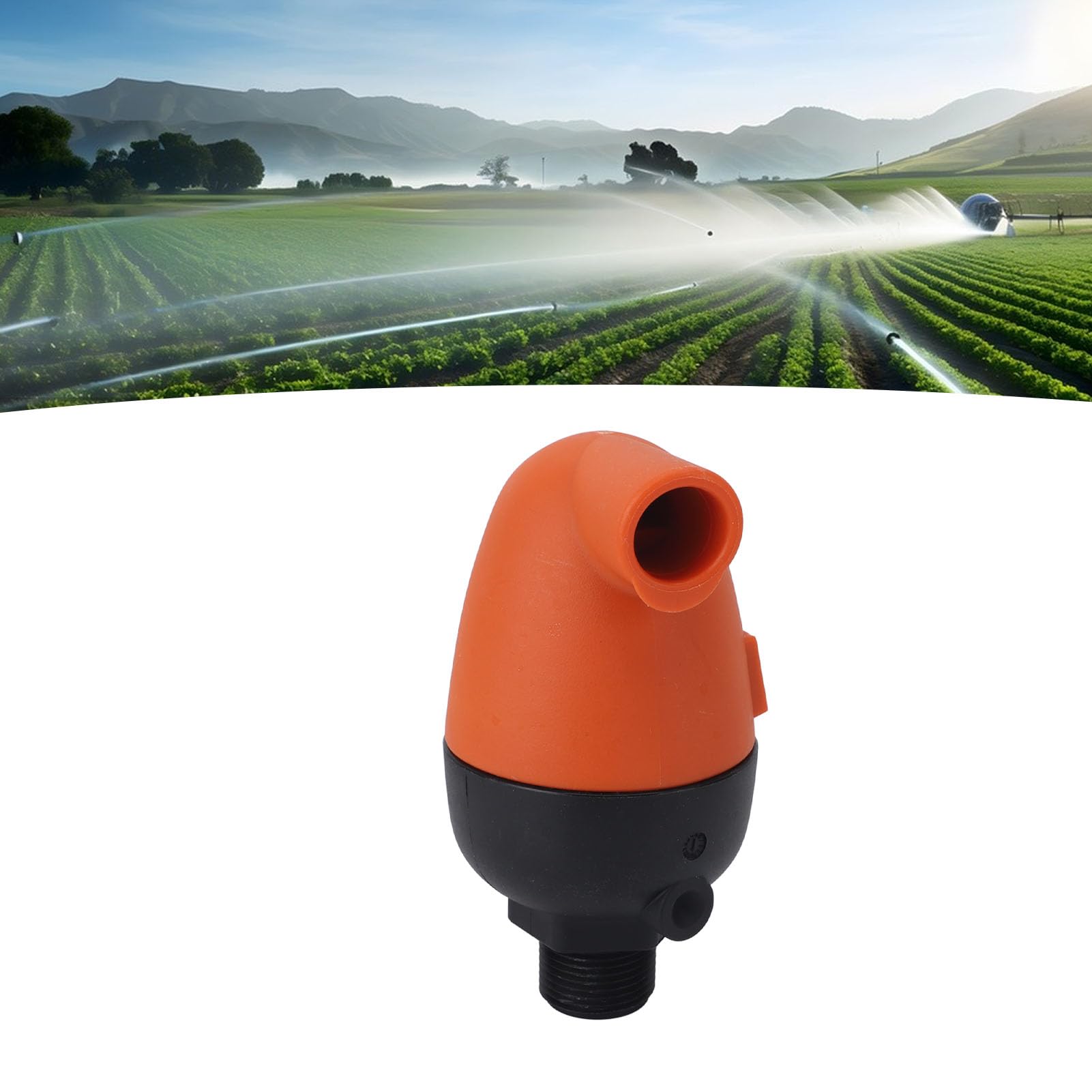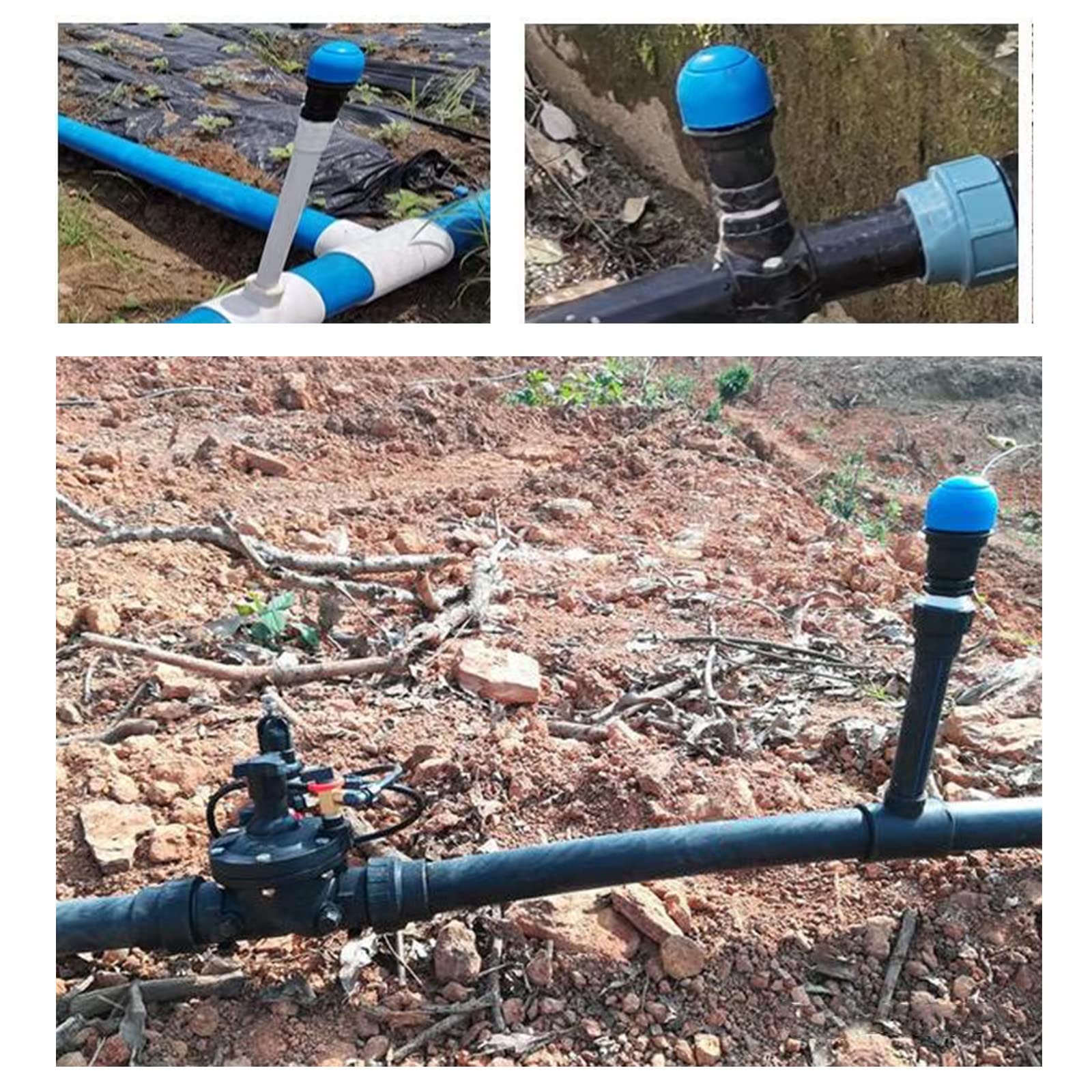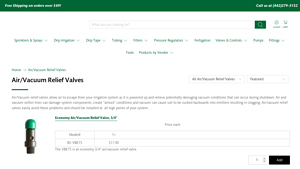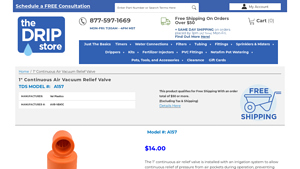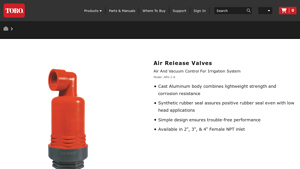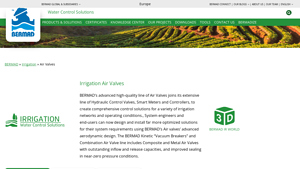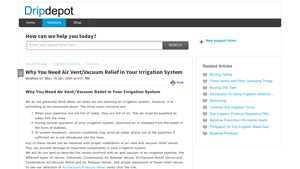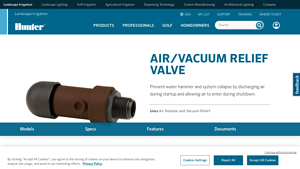Introduction: Navigating the Global Market for irrigation air release valve
In the ever-evolving landscape of global agriculture, sourcing the right irrigation air release valve can pose significant challenges for B2B buyers. These valves are crucial for maintaining the efficiency and longevity of irrigation systems, as they prevent air buildup that can lead to water hammer and system failure. This comprehensive guide delves into various types of air release valves, their applications across different agricultural settings, and the critical factors to consider when selecting suppliers.
International buyers from Africa, South America, the Middle East, and Europe, including regions like Vietnam and Saudi Arabia, will find this guide particularly beneficial. It provides insights into effective supplier vetting processes, cost considerations, and key performance indicators to ensure that your investment aligns with operational needs and sustainability goals. By leveraging the information contained within this guide, you can make informed purchasing decisions that enhance system performance while mitigating risks associated with poor-quality components.
Understanding the diverse functionalities and specifications of irrigation air release valves empowers buyers to navigate the complexities of the global market confidently. From identifying reputable manufacturers to evaluating product performance, this guide is designed to equip B2B buyers with the knowledge necessary to optimize their irrigation systems and drive productivity in their agricultural enterprises.
Understanding irrigation air release valve Types and Variations
| Type Name | Key Distinguishing Features | Primary B2B Applications | Brief Pros & Cons for Buyers |
|---|---|---|---|
| Air/Vacuum Relief Valves | Allows air to escape during operation and prevents vacuum during shutdown. | Mainline irrigation systems, drip irrigation. | Pros: Reduces risk of water hammer; prevents clogging. Cons: Requires proper placement for effectiveness. |
| Continuous Air Release Valves | Continuously releases trapped air, ensuring smooth operation. | High-capacity irrigation systems, large farms. | Pros: Maintains optimal flow; minimizes air pockets. Cons: Higher initial cost compared to standard valves. |
| Economy Air Release Valves | Cost-effective option for basic air release needs. | Smaller systems, budget-conscious projects. | Pros: Affordable; easy to install. Cons: Limited durability and functionality. |
| Aluminum Air Release Valves | Lightweight, corrosion-resistant material with synthetic seals. | Commercial applications, coastal areas. | Pros: Long-lasting; robust against environmental factors. Cons: Heavier than plastic options; may be more expensive. |
| Plastic Air Release Valves | Made from non-corrosive materials; typically lightweight. | Residential and small-scale agricultural systems. | Pros: Lightweight; resistant to corrosion. Cons: May not withstand high pressures as well as metal options. |
What Are Air/Vacuum Relief Valves and Their Applications?
Air/Vacuum Relief Valves are essential for preventing damage in irrigation systems by allowing air to escape during operation and preventing vacuum conditions during shutdown. These valves are commonly used in both mainline irrigation systems and drip irrigation setups. For B2B buyers, it’s crucial to ensure that these valves are installed at high points in the system to maximize their effectiveness and prevent potential airlock situations, which can lead to costly repairs and maintenance.
How Do Continuous Air Release Valves Benefit Large Systems?
Continuous Air Release Valves are designed to maintain optimal flow by continuously releasing trapped air. This feature is particularly beneficial for high-capacity irrigation systems and large agricultural operations where air pockets can disrupt water distribution. B2B buyers should consider the initial investment in these valves, as they often come at a higher price point. However, their ability to minimize operational disruptions and maintain system efficiency can lead to significant long-term savings.
Are Economy Air Release Valves Suitable for Smaller Projects?
Economy Air Release Valves provide a budget-friendly solution for basic air release requirements in smaller irrigation systems. These valves are easy to install and ideal for projects with limited budgets. However, buyers should be aware of their limitations in terms of durability and functionality compared to more advanced options. For businesses focusing on smaller-scale projects, these valves can be a practical choice, but they may not be suitable for high-pressure applications.
What Advantages Do Aluminum Air Release Valves Offer?
Aluminum Air Release Valves are known for their lightweight and corrosion-resistant properties, making them suitable for commercial applications, especially in coastal areas where salt exposure is a concern. These valves often feature synthetic rubber seals that ensure a tight fit even under low head applications. For B2B buyers, the investment in aluminum valves can be justified by their longevity and robustness, although they may come at a higher cost compared to plastic alternatives.
Why Choose Plastic Air Release Valves for Residential Use?
Plastic Air Release Valves are popular in residential and small-scale agricultural systems due to their lightweight and non-corrosive nature. They are typically easier to handle and install than metal valves, making them a preferred choice for smaller irrigation setups. However, buyers should consider the pressure ratings and ensure that the selected plastic valves can withstand the specific demands of their irrigation systems to avoid premature failure.
Key Industrial Applications of irrigation air release valve
| Industry/Sector | Specific Application of irrigation air release valve | Value/Benefit for the Business | Key Sourcing Considerations for this Application |
|---|---|---|---|
| Agriculture | Used in drip irrigation systems to release trapped air | Enhances water flow efficiency and prevents system damage | Ensure compatibility with existing irrigation systems |
| Horticulture | Applied in greenhouse irrigation to maintain consistent pressure | Promotes uniform watering and reduces maintenance costs | Look for durable materials resistant to environmental factors |
| Landscape Irrigation | Installed in urban landscaping systems to manage air pockets | Improves irrigation effectiveness and reduces wastage | Consider local regulations and installation requirements |
| Mining | Utilized in dust suppression systems to maintain water pressure | Enhances operational efficiency and reduces downtime | Assess the valve’s corrosion resistance for harsh environments |
| Industrial Facilities | Integrated into cooling systems to avoid cavitation in pumps | Protects equipment and extends lifespan of machinery | Evaluate flow rates and pressure ratings for specific needs |
How Are Irrigation Air Release Valves Used in Agriculture?
In agriculture, irrigation air release valves are essential for maintaining optimal water flow in drip irrigation systems. They prevent air accumulation that can disrupt water delivery, leading to uneven irrigation and potential crop damage. By allowing trapped air to escape during operation, these valves enhance system efficiency and reduce the risk of water hammer, which can harm pipes and fittings. B2B buyers in this sector should prioritize valves that are compatible with their existing infrastructure and can withstand varying environmental conditions.
What Role Do Air Release Valves Play in Horticulture?
In horticulture, air release valves are crucial for greenhouse irrigation systems. They help maintain consistent pressure by releasing air pockets that can form during operation. This ensures that water is evenly distributed across all plants, promoting healthy growth and reducing the risk of over or under-watering. Buyers should seek valves made from durable, UV-resistant materials that can withstand the unique challenges of greenhouse environments, including humidity and temperature fluctuations.
How Do Air Release Valves Improve Landscape Irrigation?
In urban landscaping, air release valves are installed to manage air pockets within irrigation systems. By preventing air accumulation, they enhance the overall effectiveness of the irrigation process, ensuring that water reaches all areas uniformly. This not only conserves water but also reduces maintenance costs associated with system repairs. Buyers should consider local regulations regarding irrigation systems and choose valves that meet these standards while providing reliable performance.
Why Are Air Release Valves Important in Mining Operations?
In the mining industry, irrigation air release valves are used in dust suppression systems to maintain consistent water pressure. They prevent cavitation in pumps, which can lead to equipment failure and increased operational downtime. By ensuring a steady flow of water, these valves contribute to effective dust control, enhancing site safety and operational efficiency. Buyers should evaluate the corrosion resistance of these valves, as mining environments can be harsh and demanding.
What Benefits Do Air Release Valves Provide in Industrial Facilities?
In industrial settings, air release valves are integrated into cooling systems to prevent cavitation and maintain optimal pump performance. By allowing air to escape, these valves protect machinery from potential damage caused by pressure fluctuations. This not only extends the lifespan of equipment but also improves overall operational efficiency. B2B buyers should assess the flow rates and pressure ratings of valves to ensure they meet the specific needs of their cooling systems, particularly in high-demand environments.
3 Common User Pain Points for ‘irrigation air release valve’ & Their Solutions
Scenario 1: Air Pockets Causing System Inefficiencies
The Problem: B2B buyers often face the challenge of air pockets forming within their irrigation systems, particularly in regions with varied topography. These air pockets can lead to inefficient water distribution, causing uneven moisture levels across fields. This not only affects crop yield but also increases the frequency of system maintenance and downtime, resulting in lost productivity and higher operational costs.
The Solution: To combat air pockets, it is essential to strategically install air release valves at the highest points of the irrigation system. Buyers should ensure they select valves that are specifically designed for their system’s pressure and flow requirements. For instance, using continuous air/vacuum relief valves can help maintain optimal system performance by allowing air to escape continuously as water flows through the pipes. When sourcing these valves, consider their specifications, such as pressure ratings and materials that resist corrosion, especially in harsh environments. Additionally, regular maintenance checks on these valves will prevent clogs and ensure they function properly, significantly enhancing the overall efficiency of the irrigation system.
Scenario 2: Water Hammer Leading to System Damage
The Problem: Water hammer is a common issue that can occur during the startup or shutdown of irrigation systems, especially in large agricultural setups. This phenomenon occurs when a sudden change in water flow creates pressure surges, potentially damaging pipes, valves, and other components. For B2B buyers, the risk of costly repairs and replacements can be a significant concern, leading to hesitance in investing in new irrigation technology.
The Solution: To mitigate water hammer effects, it is crucial to incorporate air release valves that allow air to enter the system at shutdown and exit during startup. Buyers should look for valves with features that enhance their performance, such as synthetic rubber seals that ensure a tight closure, preventing air from escaping unintentionally. When specifying valves, consider installing them at critical points in the pipeline, such as near pumps and filtration stations, to effectively manage pressure fluctuations. Moreover, implementing a gradual startup and shutdown protocol can also help minimize the risk of water hammer, ultimately protecting the integrity of the irrigation infrastructure.
Scenario 3: Clogging from Debris Infiltration
The Problem: In many irrigation systems, especially those operating in agricultural environments, debris and sediment can infiltrate the system, leading to clogging of emitters and valves. This issue is particularly pronounced in regions with high sediment loads in the water supply, posing a persistent challenge for B2B buyers responsible for maintaining system integrity and operational reliability.
The Solution: To prevent clogging, it is vital to choose air release valves equipped with built-in filters that can capture debris before it enters the system. Buyers should also consider the valve’s placement; positioning them at strategic locations—such as high points in the irrigation layout—will optimize their functionality. Additionally, investing in routine maintenance, including cleaning or replacing filters, can significantly reduce the risk of clogging. Establishing a regular inspection schedule for air release valves and associated filtration systems will help maintain optimal flow rates and protect against costly downtime caused by blockages. By ensuring that the right specifications are met and that regular maintenance is conducted, buyers can enhance the longevity and performance of their irrigation systems.
Strategic Material Selection Guide for irrigation air release valve
What Are the Common Materials Used for Irrigation Air Release Valves?
When selecting materials for irrigation air release valves, several factors such as durability, cost, and specific application requirements must be considered. Below is an analysis of four common materials used in the manufacturing of these valves, focusing on their properties, pros and cons, and implications for international B2B buyers.
1. Plastic (Polyamide or PVC)
Key Properties:
Plastic valves, often made from polyamide or PVC, are lightweight and resistant to corrosion. They typically have a pressure rating of up to 100 PSI and can operate effectively in temperatures ranging from -20°C to 60°C.
Pros & Cons:
Plastic valves are cost-effective and easy to manufacture, making them suitable for large-scale production. However, they may not withstand extreme temperatures or high pressures as well as metal alternatives, which can limit their application in more demanding environments.
Impact on Application:
These valves are ideal for use in non-corrosive environments and with clean water. However, they may not be suitable for applications involving harsh chemicals or high temperatures.
Considerations for International Buyers:
Buyers should ensure compliance with local standards such as ASTM or DIN. In regions like Africa and South America, where UV exposure is significant, UV-stabilized plastics are recommended to enhance durability.
2. Aluminum
Key Properties:
Aluminum valves are known for their lightweight yet robust structure, offering excellent corrosion resistance. They typically have a pressure rating of up to 150 PSI and can operate in a wide range of temperatures.
Pros & Cons:
The primary advantage of aluminum is its strength-to-weight ratio, making it a durable choice for various applications. However, aluminum can be more expensive than plastic and may require additional coatings to enhance corrosion resistance in certain environments.
Impact on Application:
Aluminum valves are suitable for high-pressure systems and can effectively handle air and vacuum conditions. Their durability makes them ideal for long-term installations.
Considerations for International Buyers:
Buyers in the Middle East and Europe should be aware of specific corrosion resistance requirements due to regional environmental conditions. Compliance with standards such as JIS or ASTM is crucial for ensuring product reliability.
3. Cast Iron
Key Properties:
Cast iron valves are extremely durable and can handle high pressures (up to 250 PSI) and temperatures. They are resistant to wear and tear, making them suitable for heavy-duty applications.
Pros & Cons:
The main advantage of cast iron is its exceptional durability and ability to withstand extreme conditions. However, it is heavier and more expensive than plastic or aluminum, which can increase shipping costs and installation complexity.
Impact on Application:
These valves are ideal for large-scale agricultural operations and industrial applications where high pressure and durability are required. They are less suitable for environments prone to corrosion unless properly coated.
Considerations for International Buyers:
Buyers should consider the weight and shipping implications of cast iron valves, especially in regions with limited transportation infrastructure. Compliance with local standards is also essential.
4. Stainless Steel
Key Properties:
Stainless steel valves offer high corrosion resistance and can withstand pressures up to 300 PSI. They are suitable for a wide range of temperatures and are often used in harsh environments.
Pros & Cons:
The key advantage of stainless steel is its longevity and resistance to corrosion, making it ideal for various applications, including those involving chemicals. However, it is generally the most expensive option and can be more complex to manufacture.
Impact on Application:
Stainless steel valves are perfect for systems that require high durability and corrosion resistance, such as in agricultural settings with saline water or chemicals.
Considerations for International Buyers:
In regions with stringent environmental regulations, stainless steel may be preferred due to its sustainability and recyclability. Buyers should verify compliance with international standards and local regulations.
Summary Table of Material Selection for Irrigation Air Release Valves
| Material | Typical Use Case for irrigation air release valve | Key Advantage | Key Disadvantage/Limitation | Relative Cost (Low/Med/High) |
|---|---|---|---|---|
| Plastic | Low to medium pressure systems | Cost-effective and lightweight | Limited temperature and pressure range | Low |
| Aluminum | Medium to high pressure systems | Excellent strength-to-weight ratio | Higher cost and may need coatings | Medium |
| Cast Iron | Heavy-duty agricultural and industrial applications | Exceptional durability | Heavy and expensive shipping | High |
| Stainless Steel | Harsh environments and chemical applications | High corrosion resistance | Most expensive and complex to manufacture | High |
This guide provides a comprehensive overview of material options for irrigation air release valves, helping international B2B buyers make informed decisions based on their specific needs and regional conditions.
In-depth Look: Manufacturing Processes and Quality Assurance for irrigation air release valve
What Are the Key Stages in the Manufacturing Process of Irrigation Air Release Valves?
The manufacturing of irrigation air release valves involves several critical stages, ensuring that each component meets the necessary performance and durability standards required for efficient irrigation systems. The primary stages include material preparation, forming, assembly, and finishing.
Material Preparation
The process begins with the selection of high-quality materials. Common materials for air release valves include plastics like reinforced polyamide and metals such as aluminum or brass. These materials are chosen for their corrosion resistance, durability, and lightweight properties. Once selected, raw materials undergo rigorous quality checks to ensure they meet specifications. This might involve testing for tensile strength, flexibility, and resistance to environmental factors like UV exposure.
Forming Techniques
The next stage involves forming the valve components. Techniques such as injection molding are commonly used for plastic parts, ensuring precise dimensions and surface finishes. For metal components, processes like die casting or CNC machining are employed. These methods not only enhance the structural integrity of the valves but also allow for mass production while maintaining consistency. Critical dimensions are monitored closely during this phase to prevent discrepancies that could affect valve performance.
Assembly Process
Once individual components are formed, they are assembled. This stage often involves the integration of seals, floats, and other mechanical parts. Automated assembly lines are frequently used to enhance efficiency, but manual assembly may also be employed for more complex designs. Quality control checkpoints are established during assembly to verify correct fit and function, ensuring that all moving parts operate smoothly.
Finishing Touches
The final stage is finishing, which may include surface treatments like anodizing for metal components or UV stabilization for plastic parts. These treatments enhance durability and resistance to wear. Additionally, final inspections are conducted to check for leaks and ensure that the valves meet operational pressure specifications.
How Is Quality Assurance Implemented in the Manufacturing of Air Release Valves?
Quality assurance (QA) is a critical aspect of the manufacturing process, particularly for irrigation air release valves, which must perform reliably under various conditions. Manufacturers adhere to international standards such as ISO 9001, which outlines a framework for quality management systems. Compliance with these standards is essential for maintaining product quality and consistency.
International Standards and Certifications
In addition to ISO 9001, manufacturers may pursue certifications relevant to their specific market. For instance, the CE mark is important for products sold in the European Union, indicating compliance with health, safety, and environmental protection standards. Similarly, the American Petroleum Institute (API) standards might apply to valves used in oil and gas applications, highlighting the need for industry-specific certifications.
Quality Control Checkpoints
Quality control is implemented at various checkpoints throughout the manufacturing process:
- Incoming Quality Control (IQC): Raw materials are inspected upon arrival to ensure they meet predefined specifications.
- In-Process Quality Control (IPQC): This involves monitoring critical stages of production, such as forming and assembly, to catch defects early.
- Final Quality Control (FQC): At this stage, the finished products undergo comprehensive testing for functionality, including pressure tests, leak tests, and operational checks.
What Testing Methods Are Commonly Used for Irrigation Air Release Valves?
Manufacturers utilize various testing methods to ensure that air release valves function as intended. Some common testing procedures include:
- Pressure Testing: Valves are subjected to high-pressure conditions to ensure they can withstand operational stresses without leaking.
- Leak Testing: This involves immersing the valve in water or using air pressure to detect any leaks, confirming the integrity of seals and joints.
- Functional Testing: Valves are tested in simulated operational environments to assess their performance in real-world conditions, including flow rate and response to pressure changes.
How Can B2B Buyers Verify Supplier Quality Control Measures?
For international B2B buyers, particularly from regions like Africa, South America, the Middle East, and Europe, verifying the quality control measures of suppliers is crucial. Here are several strategies to ensure supplier reliability:
- Supplier Audits: Conducting on-site audits of manufacturing facilities can provide insights into the supplier’s quality management practices, machinery, and overall operational efficiency.
- Requesting Quality Assurance Reports: Suppliers should be able to provide documentation of their quality control processes, including test results and compliance certificates for international standards.
- Third-Party Inspections: Engaging third-party inspection services can offer an unbiased assessment of the supplier’s quality processes and product integrity.
What Are the Unique Quality Control Considerations for International Buyers?
International buyers should be aware of several nuances related to quality control when sourcing irrigation air release valves. These include:
- Understanding Local Standards: Different regions may have specific quality standards and certifications that must be met. For instance, buyers in the EU must ensure products comply with CE regulations, while those in the Middle East might require GSO certification.
- Logistics and Supply Chain Integrity: The distance and logistics involved in international shipping can affect product quality. Buyers should ensure that suppliers have robust packaging and handling procedures to minimize damage during transit.
- Cultural and Communication Barriers: Engaging with suppliers from different cultural backgrounds may present challenges in communication. Clear, documented agreements regarding quality expectations and standards are essential to mitigate misunderstandings.
Conclusion
The manufacturing processes and quality assurance measures for irrigation air release valves are vital to ensuring reliable performance in irrigation systems. By understanding the key stages of manufacturing, the importance of quality control, and the testing methods employed, B2B buyers can make informed decisions when selecting suppliers. Additionally, verifying quality control measures and being aware of regional standards can enhance the procurement process, leading to better long-term partnerships in the global marketplace.
Practical Sourcing Guide: A Step-by-Step Checklist for ‘irrigation air release valve’
This guide serves as a practical checklist for B2B buyers looking to procure irrigation air release valves, ensuring you make informed decisions that meet the specific needs of your irrigation systems. Properly selected air release valves can enhance system efficiency, reduce maintenance costs, and prolong the lifespan of your equipment.
Step 1: Define Your Technical Specifications
Understanding the specific requirements of your irrigation system is crucial. Determine the size of the air release valves needed (e.g., 1″, 2″, or larger) based on your system’s design and flow rates. Additionally, consider the material (plastic vs. aluminum) that best suits your environmental conditions, as this affects durability and performance.
Step 2: Research Industry Standards and Regulations
Familiarize yourself with relevant industry standards and regulations that apply to irrigation systems in your target markets. Compliance with these standards ensures the safety and reliability of your installations. Check for certifications like ISO or local quality marks that indicate adherence to recognized best practices.
Step 3: Evaluate Potential Suppliers
Before committing to a supplier, conduct thorough evaluations. Look for suppliers with a solid track record in the irrigation sector, and request case studies or references from existing clients, particularly those in similar geographical regions. Assess their customer service capabilities and responsiveness, as this will be vital for ongoing support.
Step 4: Compare Product Features and Benefits
When assessing different air release valves, compare their features, such as continuous operation capabilities, corrosion resistance, and ease of installation. Pay attention to details like seal quality and pressure ratings, as these factors will significantly impact your system’s performance and reliability.
- Consider Warranty and Support: Ensure that the valves come with a warranty and that the supplier offers technical support for installation and troubleshooting.
Step 5: Request Samples for Testing
Whenever possible, request samples of the air release valves before placing a bulk order. Testing the products in your specific system environment allows you to evaluate their performance and compatibility. This step can help prevent costly mistakes and ensure that the valves will function as intended in your irrigation setup.
Step 6: Negotiate Pricing and Terms
Once you have identified suitable suppliers and products, engage in negotiations to secure the best pricing and terms. Consider factors such as bulk discounts, payment terms, and shipping costs. Establishing clear contractual terms helps mitigate risks and ensures a smooth procurement process.
Step 7: Plan for Installation and Maintenance
Finally, develop a plan for the installation and ongoing maintenance of the air release valves. This includes identifying qualified personnel for installation and scheduling regular maintenance checks to ensure optimal performance. Proper maintenance can prevent issues like clogging and airlock, which can significantly disrupt irrigation operations.
By following these steps, B2B buyers can streamline their procurement process for irrigation air release valves, leading to improved system efficiency and reduced operational costs.
Comprehensive Cost and Pricing Analysis for irrigation air release valve Sourcing
What Are the Key Cost Components in Sourcing Irrigation Air Release Valves?
When analyzing the cost structure for irrigation air release valves, several key components must be considered:
Materials: The choice between plastic and aluminum affects cost significantly. Aluminum valves tend to be more durable and corrosion-resistant, commanding a higher price point. Plastic options may be more affordable but can compromise longevity under harsh environmental conditions.
Labor: The manufacturing labor costs can vary based on location. Regions with higher labor costs (such as Europe) may result in increased pricing compared to countries in South America or Africa where labor is typically cheaper.
Manufacturing Overhead: This includes costs related to factory operations, utilities, and administrative expenses. Companies with more automated processes may have lower overhead costs, influencing the final pricing structure.
Tooling: Initial tooling costs for custom designs can be substantial. If a buyer requires a specific valve configuration, these costs will be amortized over the volume of valves ordered, impacting the per-unit price.
Quality Control (QC): Ensuring that products meet specific quality standards can add to manufacturing costs. Valves with certifications (such as ISO or equivalent) often have higher prices due to the rigorous testing and compliance processes involved.
Logistics: Shipping costs can vary widely based on distance and transportation mode. For international buyers, additional fees such as customs duties, tariffs, and insurance can significantly impact the total cost.
Margin: Finally, suppliers typically add a profit margin to their costs. This margin can vary based on market conditions and competitive landscape.
How Do Price Influencers Affect the Cost of Air Release Valves?
Several factors influence the pricing of irrigation air release valves:
Volume/MOQ: Bulk orders often qualify for discounts. Understanding a supplier’s minimum order quantities (MOQ) can help buyers negotiate better pricing.
Specifications and Customization: Custom valves designed for specific applications can lead to higher costs. Standardized models are generally more cost-effective.
Materials and Quality Certifications: Higher quality materials and certifications increase both the initial cost and long-term value, as they can lead to reduced maintenance and replacement expenses.
Supplier Factors: The reputation and reliability of the supplier can influence pricing. Established suppliers may charge a premium for their products, justified by their track record of quality and service.
Incoterms: Understanding shipping terms is crucial for international buyers. Costs can fluctuate dramatically based on whether the seller or buyer is responsible for transportation and associated risks.
What Negotiation Strategies Can Buyers Use to Ensure Cost Efficiency?
Leverage Volume Discounts: Buyers should consider consolidating orders to meet MOQs for better pricing. Long-term contracts may also lead to favorable terms.
Evaluate Total Cost of Ownership (TCO): Instead of focusing solely on the initial purchase price, buyers should consider the TCO, which includes installation, maintenance, and potential replacement costs over the product’s lifecycle.
Request Quotes from Multiple Suppliers: A competitive bidding process can reveal price differences and help in negotiating better deals.
Be Aware of Pricing Nuances for International Sourcing: Fluctuations in currency exchange rates can impact costs. Additionally, understanding local market conditions in regions like Africa, South America, the Middle East, and Europe can provide leverage in negotiations.
Build Relationships with Suppliers: Developing strong partnerships with suppliers can lead to more favorable pricing and terms. Regular communication can also help in identifying potential cost-saving opportunities.
Conclusion
In summary, sourcing irrigation air release valves involves a multifaceted analysis of costs and pricing. By understanding the cost components, price influencers, and effective negotiation strategies, international B2B buyers can make informed purchasing decisions that align with their operational needs while maximizing value. It is essential to remember that prices can vary significantly based on various factors, and buyers should always obtain indicative pricing tailored to their specific requirements.
Alternatives Analysis: Comparing irrigation air release valve With Other Solutions
Exploring Alternatives to Irrigation Air Release Valves
When it comes to optimizing irrigation systems, the selection of appropriate technologies is crucial. While irrigation air release valves are widely recognized for their role in preventing air lock and vacuum conditions, alternative solutions also exist that can provide similar benefits. This analysis will compare the irrigation air release valve against two viable alternatives: automatic drain valves and pressure relief valves.
Comparison Table
| Comparison Aspect | Irrigation Air Release Valve | Automatic Drain Valve | Pressure Relief Valve |
|---|---|---|---|
| Performance | Effectively releases trapped air, prevents vacuum conditions, and minimizes water hammer. | Drains excess water and prevents flooding, but does not actively manage air pockets. | Regulates pressure within the system, preventing damage from high pressure but does not address air management. |
| Cost | Typically ranges from $11.90 to $139.80 depending on size and features. | Generally lower initial cost, around $10 to $50, but may require additional components for optimal performance. | Costs vary widely, typically between $50 to $200 depending on pressure specifications and materials. |
| Ease of Implementation | Requires installation at high points in the system; can be complex depending on layout. | Easier to install as it can be placed at low points of the system. | Installation may require professional input to ensure proper pressure settings and placement. |
| Maintenance | Low maintenance but requires periodic checks for functionality. | Requires regular inspection to ensure drainage is effective and not clogged. | Minimal maintenance needed, primarily checking for pressure settings. |
| Best Use Case | Ideal for systems with varying elevations and where air pockets can form, particularly in large agricultural applications. | Best suited for systems with potential for flooding or excess water accumulation. | Effective in high-pressure environments where system protection is necessary. |
Detailed Breakdown of Alternatives
Automatic Drain Valves
Automatic drain valves are designed to release excess water from irrigation systems, especially in low-lying areas, preventing flooding. They are typically more affordable than air release valves and easier to install, making them an attractive option for smaller systems. However, they do not manage air within the system, which can lead to air pockets and inefficiencies. This limitation makes them less suitable for applications where air management is critical.
Pressure Relief Valves
Pressure relief valves play a vital role in safeguarding irrigation systems against excessive pressure, which can lead to equipment failure and costly repairs. They are particularly beneficial in high-pressure systems where the risk of damage is significant. While they provide excellent pressure management, they do not address air issues, meaning that air pockets can still form unless used in conjunction with air release valves. The cost of pressure relief valves can be higher, and their installation often requires professional expertise.
Conclusion: Choosing the Right Solution for Your Irrigation Needs
For B2B buyers evaluating irrigation solutions, the choice between an irrigation air release valve, automatic drain valve, and pressure relief valve should be guided by specific system requirements and operational conditions. If managing air pockets is a priority, particularly in agricultural applications with varied elevations, the air release valve remains the best option. However, for systems prone to flooding, automatic drain valves may offer a more cost-effective and straightforward solution. In high-pressure environments, integrating pressure relief valves can enhance system safety. Ultimately, a thorough assessment of the irrigation system’s design, expected performance, and maintenance capabilities will lead to the most effective decision.
Essential Technical Properties and Trade Terminology for irrigation air release valve
What are the Essential Technical Properties of Irrigation Air Release Valves?
Understanding the technical properties of irrigation air release valves is crucial for B2B buyers to ensure they select the right product for their needs. Below are key specifications that significantly impact performance and durability:
Material Grade
Air release valves are typically made from materials such as plastic, aluminum, or reinforced polyamide. The choice of material affects durability, resistance to corrosion, and overall performance under various environmental conditions. Buyers should consider the climate and soil characteristics of their region (e.g., high humidity in parts of Africa or saline conditions in the Middle East) when selecting the appropriate material.Pressure Rating
This specification indicates the maximum pressure the valve can handle during operation. Common pressure ratings range from 5 to 100 PSI. Understanding the pressure requirements of the irrigation system is essential, as using a valve with an insufficient pressure rating can lead to failure and costly repairs.Connection Size
Connection sizes for air release valves typically vary between 1 to 4 inches in diameter. Selecting the correct size ensures compatibility with existing piping systems. Buyers should assess their system’s specifications to avoid installation issues and ensure optimal performance.Seal Type
Many valves utilize synthetic rubber seals for effective sealing. The design of these seals impacts the valve’s ability to maintain pressure and prevent leaks. A reliable seal is crucial for preventing vacuum conditions that can lead to soil being drawn back into the system, which could cause clogging.Flow Rate
The flow rate indicates how much air the valve can release during operation, measured in cubic feet per minute (CFM). A higher flow rate allows for quicker release of trapped air, which is critical during startup and shutdown to prevent water hammer and airlocks. Buyers should consider the flow demands of their irrigation system to select a valve that meets these needs.Installation Requirements
Proper installation is vital for the effective functioning of air release valves. Specifications such as required fittings (e.g., NPT) and recommended placement (typically at high points in the system) should be considered. Misplacement can lead to system inefficiencies and maintenance challenges.
What are Common Trade Terms Related to Irrigation Air Release Valves?
Familiarity with trade terminology is essential for effective communication in procurement and supply chain processes. Here are some common terms relevant to irrigation air release valves:
OEM (Original Equipment Manufacturer)
This term refers to a company that produces parts or equipment that may be marketed by another manufacturer. Understanding OEM relationships is crucial for buyers seeking reliable and compatible components for their irrigation systems.MOQ (Minimum Order Quantity)
MOQ specifies the smallest quantity of a product that a supplier is willing to sell. Knowing the MOQ helps buyers plan their purchases effectively and avoid excess inventory, particularly in regions with variable demand.RFQ (Request for Quotation)
An RFQ is a document issued when an organization wants to buy a product and is seeking bids from suppliers. This process allows buyers to compare pricing and terms from different vendors, ensuring they secure the best deal.Incoterms (International Commercial Terms)
These are a set of international rules that define the responsibilities of buyers and sellers in international transactions. Familiarity with Incoterms is essential for buyers involved in cross-border purchases of air release valves to understand their liability for costs, risks, and responsibilities during shipping.Lead Time
This refers to the amount of time from placing an order to receiving the product. Lead time can significantly impact project timelines, especially in regions where irrigation is critical for agricultural cycles.Warranty Period
The warranty period indicates the timeframe during which a manufacturer will repair or replace defective products. Understanding warranty terms helps buyers assess the reliability of the product and the manufacturer’s commitment to quality.
By grasping these technical properties and trade terms, B2B buyers can make informed decisions that enhance the efficiency and reliability of their irrigation systems, ultimately leading to improved agricultural outcomes.
Navigating Market Dynamics and Sourcing Trends in the irrigation air release valve Sector
What Are the Current Market Dynamics and Key Trends in the Irrigation Air Release Valve Sector?
The global irrigation air release valve market is witnessing robust growth, driven by increasing agricultural demands and the need for efficient water management systems. Key factors influencing this market include the rise of precision agriculture, which emphasizes the importance of maintaining optimal pressure and flow in irrigation systems. As international B2B buyers from regions like Africa, South America, the Middle East, and Europe look to enhance agricultural productivity, the integration of advanced air release valves becomes critical. These valves help to prevent air entrapment and vacuum conditions, thus ensuring the longevity and efficiency of irrigation systems.
Emerging technologies, such as IoT-enabled smart valves, are gaining traction, allowing for real-time monitoring and control of irrigation systems. This technological evolution not only minimizes operational costs but also enhances water conservation efforts, aligning with global sustainability goals. Buyers are increasingly seeking suppliers who can offer innovative solutions and adaptable products that cater to diverse environmental conditions, particularly in regions prone to extreme weather.
Furthermore, the market is seeing a shift towards modular and customizable solutions, enabling buyers to tailor systems according to specific agricultural needs. As competition intensifies, suppliers who provide comprehensive support services, including installation and maintenance training, are more likely to succeed in attracting B2B clients.
How Important Is Sustainability and Ethical Sourcing in the Irrigation Air Release Valve Sector?
Sustainability has become a cornerstone of sourcing strategies in the irrigation air release valve market. The environmental impact of agricultural practices has led to a growing demand for products that minimize resource waste and promote eco-friendly operations. B2B buyers are increasingly prioritizing suppliers who adhere to sustainable manufacturing practices, such as using recycled materials and reducing carbon footprints during production.
Ethical sourcing is also gaining importance, as companies are held accountable for the labor practices within their supply chains. Buyers are now more inclined to partner with manufacturers that demonstrate transparency and compliance with labor regulations, thereby ensuring that their procurement practices do not contribute to social injustices.
The trend towards using “green” certifications and materials is evident, with many suppliers offering products made from biodegradable or recyclable materials. Certifications such as ISO 14001 or LEED can enhance a product’s appeal, signaling to buyers that they are investing in environmentally responsible solutions. As sustainability continues to be a key driver in procurement decisions, suppliers that align their practices with these values will likely gain a competitive edge in the market.
What Is the Evolution of Irrigation Air Release Valves in a B2B Context?
The evolution of irrigation air release valves can be traced back to the early days of modern irrigation systems, where the primary focus was on basic functionality. Initially, these valves were simple mechanical devices aimed at preventing air locks in pipelines. As agricultural practices became more sophisticated, so did the technology behind these valves.
In recent years, advancements in materials science have led to the development of more durable and corrosion-resistant options, such as aluminum and reinforced polymers. The introduction of smart technology has further transformed the landscape, allowing for automated monitoring and control, which significantly enhances system efficiency. This evolution reflects a broader trend towards precision agriculture, where every component of the irrigation system is optimized for performance and sustainability.
As the industry continues to evolve, B2B buyers can expect to see even more innovative solutions that address both operational efficiency and environmental concerns, making air release valves an integral part of modern irrigation strategies.
Frequently Asked Questions (FAQs) for B2B Buyers of irrigation air release valve
How do I solve airlock issues in my irrigation system?
To address airlock problems, ensure that air release valves are strategically installed at high points in your irrigation system. These valves allow trapped air to escape during operation, preventing the formation of air pockets that can disrupt flow and pressure. Regular maintenance checks can also help identify and resolve any blockages or malfunctions in the valves. If airlock persists, consider increasing the number of air release valves or using continuous air/vacuum relief valves for more effective air management.What is the best air release valve for drip irrigation systems?
The best air release valve for drip irrigation systems typically combines durability and performance, such as a continuous air/vacuum relief valve. Look for options made from corrosion-resistant materials, like aluminum or reinforced polyamide, with a reliable sealing mechanism. Valves that can handle varying pressure levels (5-100 PSI) are ideal, as they accommodate different system requirements. Always consult with your supplier to match the valve specifications with your system’s design and operational needs.How do I vet suppliers for air release valves in international markets?
When vetting suppliers, prioritize those with a strong reputation in the irrigation industry. Check for certifications, customer reviews, and their experience in international trade. Request product samples to evaluate quality and ensure compliance with your regional standards. Additionally, inquire about their manufacturing processes and supply chain reliability. Engaging in direct communication can provide insights into their customer service approach and responsiveness.What are the typical minimum order quantities (MOQs) for air release valves?
Minimum order quantities can vary significantly by supplier and the type of air release valve. Generally, MOQs range from 50 to 200 units for standard models. However, some suppliers may offer flexibility based on your specific needs or if you are a returning customer. Always negotiate with suppliers to find a mutually beneficial arrangement, especially if you are testing new products or entering a new market.What payment terms should I expect when purchasing air release valves internationally?
Payment terms can differ based on supplier policies and the nature of the transaction. Common terms include upfront payment, a 30% deposit with the balance due before shipping, or net 30-60 days. It’s advisable to clarify terms early in negotiations and consider using secure payment methods, such as letters of credit, for higher-value transactions. Establishing a good rapport with your supplier may also lead to more favorable terms over time.How can I ensure quality assurance for the air release valves I order?
To ensure quality assurance, request detailed product specifications and certifications from your supplier. Inquire about their quality control processes, including testing protocols and inspections conducted during manufacturing. You may also consider third-party inspections prior to shipping to verify compliance with your standards. Building a long-term relationship with your supplier can facilitate trust and improve quality consistency over time.What are the logistics considerations for importing air release valves?
Logistics considerations include shipping methods, customs clearance, and potential tariffs or duties that may apply to your order. Choose a reliable freight forwarder experienced in handling agricultural equipment to streamline the process. Ensure that all documentation, such as invoices and packing lists, is accurate to prevent delays at customs. Discuss lead times with your supplier to plan for potential delays and maintain adequate inventory levels.Can I customize air release valves for my specific irrigation needs?
Yes, many suppliers offer customization options for air release valves to better suit specific irrigation applications. Customizations may include size, pressure ratings, and materials used in manufacturing. When discussing customization, provide detailed specifications and requirements to your supplier. Keep in mind that custom orders may have longer lead times and potentially higher costs, so plan accordingly.
Important Disclaimer & Terms of Use
⚠️ Important Disclaimer
The information provided in this guide, including content regarding manufacturers, technical specifications, and market analysis, is for informational and educational purposes only. It does not constitute professional procurement advice, financial advice, or legal advice.
While we have made every effort to ensure the accuracy and timeliness of the information, we are not responsible for any errors, omissions, or outdated information. Market conditions, company details, and technical standards are subject to change.
B2B buyers must conduct their own independent and thorough due diligence before making any purchasing decisions. This includes contacting suppliers directly, verifying certifications, requesting samples, and seeking professional consultation. The risk of relying on any information in this guide is borne solely by the reader.
Top 6 Irrigation Air Release Valve Manufacturers & Suppliers List
1. Grow Irrigation – Economy Air/Vacuum Relief Valve
Domain: growirrigation.com
Registered: 2019 (6 years)
Introduction: [{‘name’: ‘Economy Air/Vacuum Relief Valve, 3/4″‘, ‘price’: ‘$11.90’, ‘model’: ‘B5-VBK75’, ‘description’: ‘An economy 3/4″ air/vacuum relief valve.’}, {‘name’: ‘Air/Vacuum Relief Valve, 2″‘, ‘price’: ‘$76.00’, ‘model’: ‘B5-SSE2’, ‘description’: ‘A high performance 2″ air/vacuum relief valve.’}, {‘name’: ‘Continuous Air/Vacuum Relief Valve, 2″‘, ‘price’: ‘$139.80’, ‘model’: ‘B5-SDE2’, ‘description’…
2. Val Plastics – 1 Continuous Air Vacuum Relief Valve
Domain: dripirrigation.com
Registered: 1997 (28 years)
Introduction: {“product_name”: “1” Continuous Air Vacuum Relief Valve”, “model_number”: “A157”, “manufacturer”: “Val Plastics”, “sku”: “AVR-VBK1C”, “price”: “$14.00”, “features”: [“Allows continuous relief of pressure from air pockets during operation”, “Prevents pipes and fittings from cracking or bursting”, “Reduces chance of water hammer damage caused by sudden reversal of water flow”, “Float design ensures …
3. Toro – ARV-1-K Air Release Valve
Domain: toro.com
Registered: 1994 (31 years)
Introduction: {“model”:”ARV-1-K”,”type”:”Air Release Valve”,”material”:”Cast Aluminum”,”features”:[“Corrosion resistance”,”Lightweight strength”,”Synthetic rubber seal for positive sealing even with low head applications”,”Simple design for trouble-free performance”],”sizes_available”:[“2 inch Female NPT inlet”,”3 inch Female NPT inlet”,”4 inch Female NPT inlet”],”function”:”Air and vacuum control for drip irri…
4. BERMAD – Advanced Air Valves
Domain: bermad.com
Registered: 1996 (29 years)
Introduction: BERMAD’s advanced high-quality line of Air Valves includes Kinetic Vacuum Breakers and Combination Air Valves, featuring Composite and Metal options. These valves are designed for optimized irrigation networks, offering outstanding inflow and release capacities, and improved sealing in near-zero pressure conditions. Key products include: Combination Air Valve IR-C10-P, IR-C70-C, IR-C30, IR-C35-P, …
5. Drip Depot – Air Vent Vacuum Relief Valves
Domain: help.dripdepot.com
Registered: 2005 (20 years)
Introduction: Air Vent Vacuum Relief Valves are essential for irrigation systems to manage air and vacuum conditions. Key types include: 1. Automatic (Continuous) Air Release Valves – release small amounts of air after system pressurization. 2. Air Release/Vacuum Relief Valves – discharge large volumes of air during filling and allow air intake during draining. 3. Combination Air/Vacuum Relief and Air Release V…
6. Hunter – Air/Vacuum Relief Valves
Domain: hunterirrigation.com
Registered: 2001 (24 years)
Introduction: Product Name: Air/Vacuum Relief Valve
Product Line: Micro Irrigation
Models:
– PLD-AVR Air/Vacuum Relief Valve, ½” male thread
– AVR-075 Air/Vacuum Relief Valve, ¾” MPT
Specifications:
– Material: UV-protected and corrosion-resistant
– Operating Pressure Range: up to 80 PSI
– Warranty Period: 2 years
Features:
– Releases adequate air flow at high points during start-up and shutdown
– Prevents w…
Strategic Sourcing Conclusion and Outlook for irrigation air release valve
In today’s competitive agricultural landscape, the strategic sourcing of irrigation air release valves is paramount for maintaining system efficiency and longevity. These valves are essential in preventing air pockets and vacuum conditions that can lead to costly damages and operational inefficiencies. By selecting high-quality air release valves, businesses can not only protect their irrigation infrastructure but also enhance water distribution uniformity, ultimately improving crop yields.
For B2B buyers in regions like Africa, South America, the Middle East, and Europe, understanding the nuances of air release valve technology can significantly influence procurement decisions. Factors such as material durability, valve design, and ease of installation should guide your sourcing strategy. Collaborating with reputable suppliers who offer a range of options tailored to your specific climate and agricultural needs will ensure optimal performance.
As we look to the future, the demand for reliable irrigation solutions will continue to rise. Now is the time to invest in strategic sourcing practices that align with your business goals. Explore partnerships with trusted manufacturers to secure the best air release valves that enhance your irrigation systems, paving the way for sustainable agricultural practices and improved economic outcomes.

